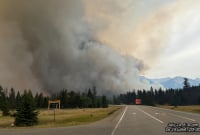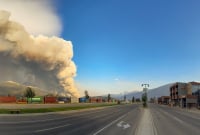Support strong Canadian climate journalism for 2025
Following the Jasper wildfire, some media commentators have argued that we should spend less on fighting climate change and more on adapting to its effects. That is a dangerously incorrect argument for two reasons.
The first and main flaw is that this argument is self-defeating. If we cut back on our efforts to reduce greenhouse gas (GHG) emissions, damages from climate change will increase, requiring us to do even more to adapt to its impacts. More climate change means more floods, fires and severe weather.
The studies are clear: If we do not deal with the underlying causes of climate change, the costs of managing the damages will be much higher.
For instance, just a one degree temperature increase above the Paris Agreement target will mean Canada pays more than $100 billion for additional climate-related damages by 2050, according to a recent study.
It is like arguing that we should reduce preventative efforts in health care and spend more on treatment. If we do not deal with the causes of poor health (such as smoking, dirty air and water and lack of exercise), public health problems will worsen and cost more to treat. An ounce of prevention really is worth a pound of cure — and the same is true for climate change.
The second flaw is the assumption that doing more on climate adaptation must mean doing less to fight climate change. This is a false choice and both are important. Yes, we should do more to manage and adapt to the damages caused by climate change. But we also should do more to reduce the GHG emissions that cause it.
Better still, we should tackle both problems together wherever possible. For example, with smart building codes that cut energy use and also reduce fire and flooding damages, or more sustainable forest policies that reduce fire risks and conserve more carbon in nature.
It is dangerous to argue that, for a major public threat, we must choose between treatment or prevention. No one would say we must choose between investing in hospitals and anti-smoking efforts or between crime prevention and punishment.
It is true that as climate change worsens, the damage will, too. Scientists have predicted this for decades and now, we see it all around us. Some level of climate change has become inevitable. We have no choice as a society but to responsibly prepare for more (and more destructive) extreme weather.
But we should also limit the damage by doing our share in the global effort to tackle the root issue.
Canada is finally starting to make real progress on that front, after years of inaction. After signing the Global Climate Treaty in 1992, Canada’s federal governments, both Liberal and Conservative, did almost nothing to tackle climate change for the next 23 years. A few provinces and cities, to their credit, did make laudable efforts. Since 2016, however, Canada has done more than most countries to bring in effective climate policies and investments.
And results are starting to show. From 1992 to 2015, Canada’s GHG emissions rose by 20 per cent. Since 2016, they have fallen by five per cent, and they will continue to fall if we maintain and strengthen our current climate policies.
We have finally started to turn the corner. Yes, like all countries, we must do more. But we now have a credible plan to reduce emissions by more than 30 per cent by 2030 — most experts agree — if we stick to it.
It is not just about reducing emissions. Canada has invested billions of dollars, matched by private funds, to help key industries across the country — such as automotive, agriculture, steel, forestry and mining — retool to succeed in the emerging, global, low-carbon economy.
If we cut that funding, as some argue, it would not just mean fewer emissions reductions. We will miss significant economic opportunities, costing us jobs, investment and wealth. This is a lose-lose idea.
So, yes, let us invest more in climate adaptation. But let us also redouble our efforts to cut emissions and build a cleaner, stronger Canadian economy. We can and must do both.
Stewart Elgie is Jarislowsky Chair of Clean Economy and Innovation at the University of Ottawa, and founder of the Smart Prosperity Institute.
Kathy Bardswick is former President and CEO of The Cooperators Group (2002-16) and the Canadian Climate Institute (2019-21), and Chair of the federal Sustainable Finance Action Council.







Comments